At the end of the season, were there a few things you would have done differently? It’s true for everyone—no matter how long we’ve been gardening, there are always things we want to change. The garden is constantly evolving.
I’ve been gardening on a shaded one-third acre parcel for 16 years and would consider myself an experienced gardener. Yet, there are at least five things I could have done better or would change next year. Not a year goes by when Mother Nature doesn’t teach me a lesson, often because I challenge myself to try at least one new plant every year. Making mistakes can be the best way to learn how to be a better gardener.
I’m sharing five of my gardening mistakes here in hopes that you can learn from them just like I have.
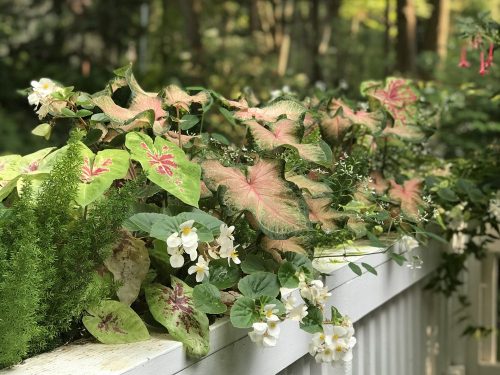
Mistake #1 – Planting too early.
After a long winter, I am always eager to get back out into the garden. I do my plant shopping in early May and exercise all the patience I can muster to wait to plant outside until temperatures are consistently above 50°F for annuals and above freezing for perennials, trees and shrubs.
It’s easy to forget that tropical plants like caladium and colocasia need temperatures to be consistently above 60 to 65°F to adapt well to growing outdoors. Plus, they need the soil temperature to be at least 65°F. If you plant them outside when it’s too cold, they can easily become stunted or rot in the cold, wet conditions that are common in the spring.
I made the mistake of planting the caladiums in this porch rail box too early in the spring and they rotted as a result. I replaced them in mid-June once the weather was more appropriate and then they thrived all the way through early fall.
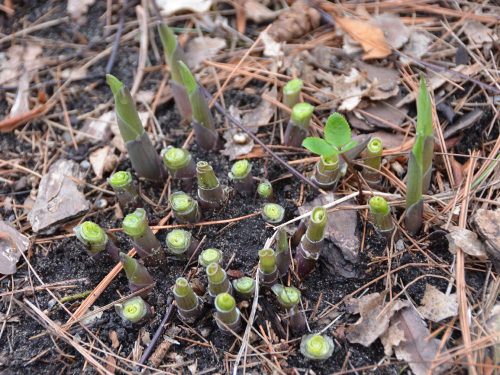
Mistake #2 – Not applying animal repellent in early spring.
When you work in the nursery business, spring is an incredibly busy time. It’s easy to forget to reapply animal repellent almost as soon as the snow melts, just as the garden begins to wake up in the spring. Rabbits, voles, mice and deer are incredibly hungry and looking for anything they could possibly eat in your garden that time of year. You can see how the rabbits made a meal of this emerging hosta in my garden last spring.
It’s essential to apply animal repellent very early in the season. Sprinkle a granular repellent around the base of emerging perennials like hostas and coral bells and follow up with a liquid spray repellent when the foliage reaches about 6 inches tall. You want to train garden pests from the very beginning of the season that your plants are off limits.
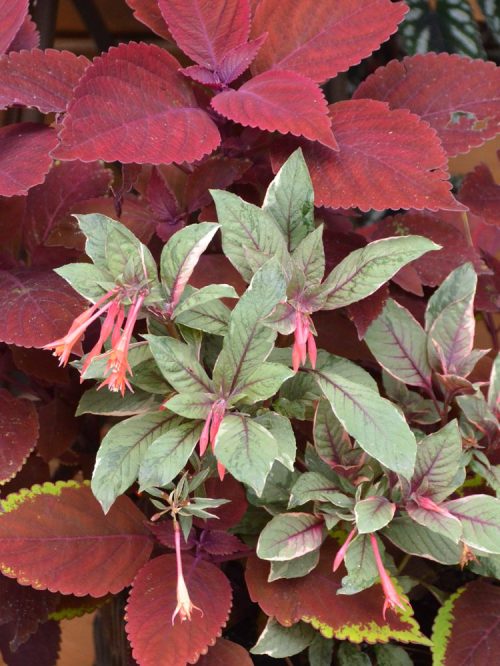
Mistake #3 – Pairing plants of unequal vigor in container combinations.
Knowing which plants grow well together in container combinations is something that takes time and experience to master. Expect to have some plants that won’t grow large or fast enough to keep up and others that are a bit too exuberant. Taking notes or photographing your containers through the season is a good way to keep track of what works and what doesn’t. This article also has lots of tips on how to choose container companions.
I grew ColorBlaze® Rediculous® coleus for the first time this year and was astounded by its vigor. It grew as large as a shrub in a single season in the shade. Though the pairing with this variegated Firecracker fuchsia was stunning, it wasn’t long before the coleus took over. Next year, I will grow it by itself in a container or in the landscape where it can have all the room it needs to shine.
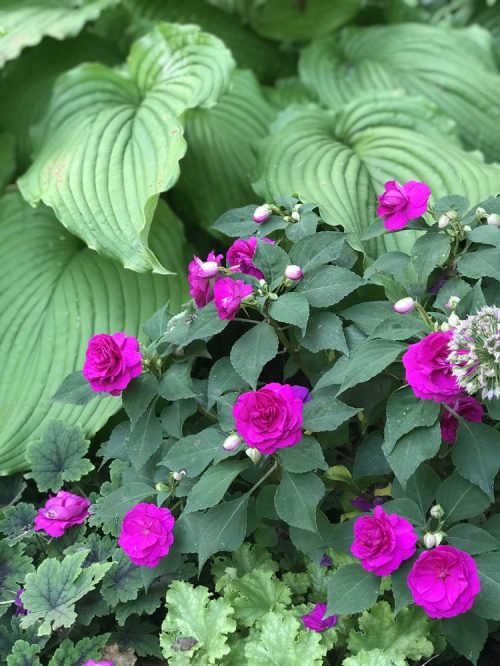
Mistake #4 – Not feeding annual flowers often enough.
If you want your double and bedding impatiens, petunias, calibrachoa, verbena, geraniums, and other popular annuals to bloom prolifically, you need to feed them. We recommend feeding with Proven Winners premium water-soluble plant food every third time you water or at least once per week. Additionally, mix a scoop of continuous release plant food into the soil when you plant. Together, these two kinds of fertilizers will help you get the most out of your plants all season.
The Rockapulco® Purple double impatiens shown here in my garden were pretty, but only had about one-third of their normal quantity of flowers because they hadn’t been fed in a month. The continuous release plant food I mixed into the soil when I planted them carried them through and kept the plants healthy until I fed them again with water soluble plant food. If I had done so more often, they would have bloomed better without slowing down in between feedings.
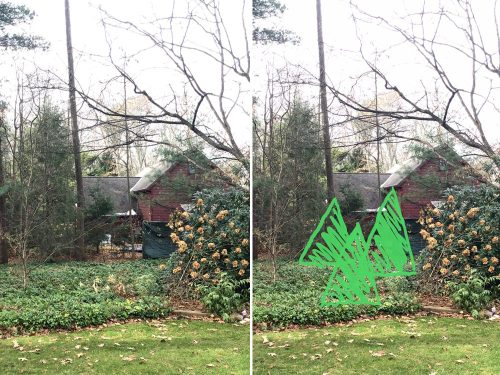
Mistake #5 – Not planting enough evergreens.
Winter is when mistake #5 becomes very obvious—not planting enough evergreen plants to screen unsightly views once all of the deciduous plants in your landscape have dropped their leaves. When you look out your windows this time of year, are there places where you could use a few new evergreens?
This view out my kitchen window is completely screened by a Japanese maple tree, witch hazel shrub, Fire Light® panicle hydrangea and tall perennials from spring through fall. But once those plants go dormant, I am left staring at the back of my neighbor’s garage and everything they store behind it all winter.
I used my iPad to take a photo of the space and sketched a few shade tolerant evergreen false cypress trees on it to visualize what it could look like in the winter. A huge improvement, don’t you agree? Try it yourself to reimagine your garden spaces this winter.
What gardening mistakes did you make this season? No worries, there is always next year! Start planning today.

6 thoughts on “5 Gardening Mistakes Even Experienced Gardeners Make”
I’ve been dealing with a terrible deer invasion for years. This year I’m following Erin’s (Impatient Gardener and spraying my shrubs all winter. I like your tip to sprinkle granular around my hostas in the spring though. I’m going to win this battle yet!
My biggest problem is not fertilizing enough. I have a lot of plants, and trouble having money to fertilize enough. I’m open to suggestions of the best way to fertilize.
I vow to follow through with a weekly fertilizing of my annuals. I alway apply the time release fertilizer when planting, but have not followed through with a weekly.
As a Master Gardener with years and years of gardening in my background you would think I wouldn’t make any mistakes but oh yes I do! I make doozies too. But I don’t get too emotionally attached to my plants so my garden is always in transition. If it doesn’t please me it gets pulled out and given away to someone. It’s when I planted some irises many years ago, Siberian irises that is, and little did I know they were going to spread like wildfire. I finally dug the whole Clump out and put one in a pot so we shall see what happens next season.
I have been gardening for 46 years on my quarter-acre. I took out 14 trees (it was a locust forest) and have almost total shade or part shade. The biggest problem I have is that I see a wonderful plant and buy one to try, and it usually needs much more sun. Thanks for the tip to put critter resistance when the plants first appear. I usually wait until damage, but your idea is better.
Planting things too close together – they need the space to thrive and every year in some part of my garden I seem to lose patience. I plant 5 instead of 3 or 3 instead of 1 wanting color asap. This year I am going to concentrate on following the planting directions for spacing, feed on a more regular schedule and be patient.